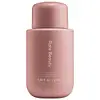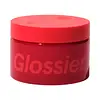What's inside
What's inside
 Key Ingredients
Key Ingredients

 Benefits
Benefits

 Concerns
Concerns

 Ingredients Side-by-side
Ingredients Side-by-side

Water
Skin ConditioningGlycerin
HumectantButylene Glycol
HumectantCaprylic/Capric Triglyceride
MaskingButyrospermum Parkii Butter
Skin ConditioningHydrogenated Polydecene
EmollientNiacinamide
Smoothing1,2-Hexanediol
Skin ConditioningParfum
MaskingMacadamia Integrifolia Seed Oil
Skin ConditioningBehenyl Alcohol
EmollientPrunus Persica Flower Extract
MoisturisingSodium Benzoate
MaskingAcrylates/C10-30 Alkyl Acrylate Crosspolymer
Emulsion StabilisingPolyglyceryl-3 Methylglucose Distearate
EmulsifyingCetyl Alcohol
EmollientHydroxyethyl Acrylate/Sodium Acryloyldimethyl Taurate Copolymer
Emulsion StabilisingPolymethylsilsesquioxane
Vinyldimethicone
Glyceryl Stearate
EmollientCaprylyl Glycol
EmollientChlorella Vulgaris Extract
Skin ConditioningGlucose
HumectantFructooligosaccharides
HumectantFructose
HumectantXanthan Gum
EmulsifyingCitric Acid
BufferingTromethamine
BufferingEthylhexylglycerin
Skin ConditioningSodium Citrate
BufferingSodium Phytate
Beta-Glucan
Skin ConditioningSodium Hyaluronate
HumectantWithania Somnifera Root Extract
Skin ConditioningHydroxypropyltrimonium Hyaluronate
Tocopherol
AntioxidantHydrolyzed Hyaluronic Acid
HumectantSodium Acetylated Hyaluronate
HumectantHyaluronic Acid
HumectantHydrolyzed Sodium Hyaluronate
Skin ConditioningSodium Hyaluronate Crosspolymer
HumectantPotassium Hyaluronate
Skin ConditioningLimonene
PerfumingCoumarin
PerfumingLinalool
PerfumingCitral
PerfumingWater, Glycerin, Butylene Glycol, Caprylic/Capric Triglyceride, Butyrospermum Parkii Butter, Hydrogenated Polydecene, Niacinamide, 1,2-Hexanediol, Parfum, Macadamia Integrifolia Seed Oil, Behenyl Alcohol, Prunus Persica Flower Extract, Sodium Benzoate, Acrylates/C10-30 Alkyl Acrylate Crosspolymer, Polyglyceryl-3 Methylglucose Distearate, Cetyl Alcohol, Hydroxyethyl Acrylate/Sodium Acryloyldimethyl Taurate Copolymer, Polymethylsilsesquioxane, Vinyldimethicone, Glyceryl Stearate, Caprylyl Glycol, Chlorella Vulgaris Extract, Glucose, Fructooligosaccharides, Fructose, Xanthan Gum, Citric Acid, Tromethamine, Ethylhexylglycerin, Sodium Citrate, Sodium Phytate, Beta-Glucan, Sodium Hyaluronate, Withania Somnifera Root Extract, Hydroxypropyltrimonium Hyaluronate, Tocopherol, Hydrolyzed Hyaluronic Acid, Sodium Acetylated Hyaluronate, Hyaluronic Acid, Hydrolyzed Sodium Hyaluronate, Sodium Hyaluronate Crosspolymer, Potassium Hyaluronate, Limonene, Coumarin, Linalool, Citral
Water
Skin ConditioningGlycerin
HumectantCetearyl Alcohol
EmollientButyrospermum Parkii Butter
Skin ConditioningCaprylic/Capric Triglyceride
MaskingHelianthus Annuus Seed Oil
EmollientParfum
MaskingPolyglyceryl-3 Stearate
EmulsifyingSimmondsia Chinensis Seed Oil
EmollientGlyceryl Caprylate
EmollientCellulose
AbsorbentCopernicia Cerifera Wax
Glyceryl Laurate
EmollientSclerotium Gum
Emulsion StabilisingCaprylhydroxamic Acid
Phytic Acid
Citric Acid
BufferingPotassium Sorbate
PreservativeHydroxycitronellal
PerfumingHexyl Cinnamal
PerfumingFarnesol
PerfumingLimonene
PerfumingWater, Glycerin, Cetearyl Alcohol, Butyrospermum Parkii Butter, Caprylic/Capric Triglyceride, Helianthus Annuus Seed Oil, Parfum, Polyglyceryl-3 Stearate, Simmondsia Chinensis Seed Oil, Glyceryl Caprylate, Cellulose, Copernicia Cerifera Wax, Glyceryl Laurate, Sclerotium Gum, Caprylhydroxamic Acid, Phytic Acid, Citric Acid, Potassium Sorbate, Hydroxycitronellal, Hexyl Cinnamal, Farnesol, Limonene
 Reviews
Reviews

Ingredients Explained
These ingredients are found in both products.
Ingredients higher up in an ingredient list are typically present in a larger amount.
This ingredient is also known as shea butter. It is an effective skin hydrator and emollient.
Emollients help soothe and soften your skin. It does this by creating a protective film on your skin. This barrier helps trap moisture and keeps your skin hydrated. Emollients may be effective at treating dry or itchy skin.
Shea butter is rich in antioxidants. Antioxidants help fight free-radicals, or molecules that may harm the body. It is also full of fatty acids including stearic acid and linoleic acid. These acids help replenish the skin and keep skin moisturized.
While Shea Butter has an SPF rating of about 3-4, it is not a sunscreen replacement.
Shea butter may not be fungal acne safe. We recommend speaking with a professional if you have any concerns.
Learn more about Butyrospermum Parkii ButterThis ingredient is an emollient, solvent, and texture enhancer. It is considered a skin-softener by helping the skin prevent moisture loss.
It helps thicken a product's formula and makes it easier to spread by dissolving clumping compounds.
Caprylic Triglyceride is made by combining glycerin with coconut oil, forming a clear liquid.
While there is an assumption Caprylic Triglyceride can clog pores due to it being derived from coconut oil, there is no research supporting this.
Learn more about Caprylic/Capric TriglycerideCitric Acid is an alpha hydroxy acid (AHA) naturally found in citrus fruits like oranges, lemons, and limes.
Like other AHAs, citric acid can exfoliate skin by breaking down the bonds that hold dead skin cells together. This helps reveal smoother and brighter skin underneath.
However, this exfoliating effect only happens at high concentrations (20%) which can be hard to find in cosmetic products.
Due to this, citric acid is usually included in small amounts as a pH adjuster. This helps keep products slightly more acidic and compatible with skin's natural pH.
In skincare formulas, citric acid can:
While it can provide some skin benefits, research shows lactic acid and glycolic acid are generally more effective and less irritating exfoliants.
Most citric acid used in skincare today is made by fermenting sugars (usually from molasses). This synthetic version is identical to the natural citrus form but easier to stabilize and use in formulations.
Read more about some other popular AHA's here:
Learn more about Citric AcidGlycerin is already naturally found in your skin. It helps moisturize and protect your skin.
A study from 2016 found glycerin to be more effective as a humectant than AHAs and hyaluronic acid.
As a humectant, it helps the skin stay hydrated by pulling moisture to your skin. The low molecular weight of glycerin allows it to pull moisture into the deeper layers of your skin.
Hydrated skin improves your skin barrier; Your skin barrier helps protect against irritants and bacteria.
Glycerin has also been found to have antimicrobial and antiviral properties. Due to these properties, glycerin is often used in wound and burn treatments.
In cosmetics, glycerin is usually derived from plants such as soybean or palm. However, it can also be sourced from animals, such as tallow or animal fat.
This ingredient is organic, colorless, odorless, and non-toxic.
Glycerin is the name for this ingredient in American English. British English uses Glycerol/Glycerine.
Learn more about GlycerinLimonene is a fragrance that adds scent and taste to a formulation.
It's found in the peel oil of citrus fruits and other plants such as lavender and eucalyptus. The scent of limonene is generally described as "sweet citrus".
Limonene acts as an antioxidant, meaning it helps neutralize free radicals.
When exposed to air, oxidized limonene may sensitize the skin. Because of this, limonene is often avoided by people with sensitive skin.
The term 'fragrance' is not regulated in many countries. In many cases, it is up to the brand to define this term. For instance, many brands choose to label themselves as "fragrance-free" because they are not using synthetic fragrances. However, their products may still contain ingredients such as essential oils that are considered a fragrance.
Learn more about LimoneneParfum is a catch-all term for an ingredient or more that is used to give a scent to products.
Also called "fragrance", this ingredient can be a blend of hundreds of chemicals or plant oils. This means every product with "fragrance" or "parfum" in the ingredients list is a different mixture.
For instance, Habanolide is a proprietary trade name for a specific aroma chemical. When used as a fragrance ingredient in cosmetics, most aroma chemicals fall under the broad labeling category of “FRAGRANCE” or “PARFUM” according to EU and US regulations.
The term 'parfum' or 'fragrance' is not regulated in many countries. In many cases, it is up to the brand to define this term.
For instance, many brands choose to label themselves as "fragrance-free" because they are not using synthetic fragrances. However, their products may still contain ingredients such as essential oils that are considered a fragrance by INCI standards.
One example is Calendula flower extract. Calendula is an essential oil that still imparts a scent or 'fragrance'.
Depending on the blend, the ingredients in the mixture can cause allergies and sensitivities on the skin. Some ingredients that are known EU allergens include linalool and citronellol.
Parfum can also be used to mask or cover an unpleasant scent.
The bottom line is: not all fragrances/parfum/ingredients are created equally. If you are worried about fragrances, we recommend taking a closer look at an ingredient. And of course, we always recommend speaking with a professional.
Learn more about ParfumWater. It's the most common cosmetic ingredient of all. You'll usually see it at the top of ingredient lists, meaning that it makes up the largest part of the product.
So why is it so popular? Water most often acts as a solvent - this means that it helps dissolve other ingredients into the formulation.
You'll also recognize water as that liquid we all need to stay alive. If you see this, drink a glass of water. Stay hydrated!
Learn more about Water